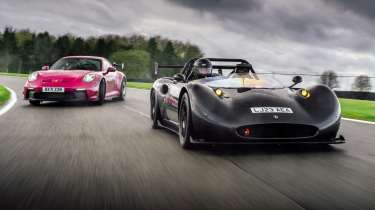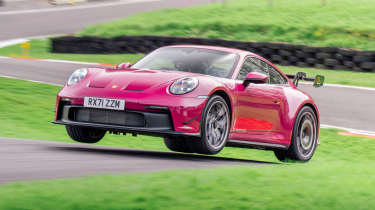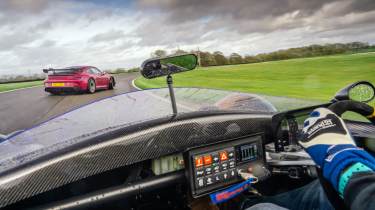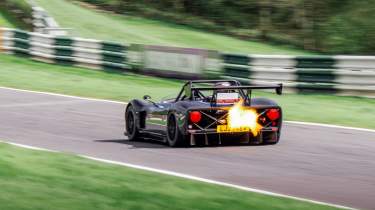Porsche 911 GT3 Manthey Racing v Spartan: £200,000 track toys battle it out
A Porsche sprinkled with Manthey Racing fairy dust, and a retro-look trackday weapon with very up-to-date performance battle it out on track
You’d struggle to find two more different cars than the Manthey-tweaked 992 GT3 MR and the supercharged Spartan, yet each occupies a similar place in the trackday hierarchy. Neither is likely to be an only car, so although the GT3 MR is more useable, both are likely to be reserved for trackdays and recreational road driving. As-tested the Manthey package adds more than £60,000 to the list price of a GT3 (call it £210,000 all-in), while this top-spec Spartan is £175,000. Big boys’ (or girls’) toys, in other words.
The notion of meddling with the factory 992 GT3 might seem crazy, especially if it lifts the price above that of a GT3 RS. But Manthey Racing – once an independent team, now owned by Porsche – are motorsport royalty courtesy of seven victories in the Nürburgring N24, all in 911s. It might be a niche within a niche, but to those who know, the MR tag carries huge kudos.
> Ariel Atom 4R v Caterham Seven ‘evo25’: power-to-weight heroes go head-to-head
The Manthey Performance Kit centres on the chassis, which trades PASM for a Manthey four-way adjustable passive set-up. Nose-to-tail aero changes add front dive planes and a new front splitter, a bigger rear wing and diffuser, plus carbon aerodiscs if you also fit the optional OM‑1 lightweight alloys. Braided brake lines, harder pads and some Manthey branding complete the package, the powertrain remaining untouched.
More reviews
Group tests
In-depth reviews
- Porsche 911 review 2025 – Gen2 992 is the 911 for the digital age
- Used Porsche 911 (991, 2011 - 2018) review – should you buy the unloved 911?
Long term tests
Reviews
How different does it feel to a stock GT3? ‘Very’ is the swift conclusion. It’s a stiff set-up with less low-speed pliancy – something you notice as soon as you leave the paddock but forget once you build speed and tyre temps. Fundamentally, where a regular GT3 feels planted and well-matched front-to-rear, the MR has greater rotational energy as soon as you turn in. Initially this makes you catch your breath, as you can’t believe the tail will cope with the front end’s rate of turn into corners, especially high-speed ones, but as familiarity and commitment grow you learn this keenness successfully treads a finely judged line. It’s a tremendously exciting car. One that feels on more of a razor’s edge than the factory GT3, but pays back with switch-like responses and an ability to find grip and traction that’s beyond the stock model.
How close does it get to the factory 992 GT3 RS? In all-out terms, a fraction under a second (1:32.26 versus 1:31.34), though they deliver in very different ways. The MR isn’t in the RS’s league for downforce, but you feel the revised aero working harder. And since the added stability doesn’t come with the same drag penalty, the MR feels more accelerative. This is corroborated by the Vbox, which logs a fractionally higher peak speed for the MR on Park Straight (137.5mph v 136.9mph), despite a minimum speed that’s 9mph slower through the preceding corner (94.7mph v 103.4mph). Ultimately the MR will make little sense to those who are oblivious to the allure of Manthey’s fairy dust. Me? I love it.
The bare-carbon Spartan is quite the weapon. Limited to a build run of 300 cars (Spartan. 300. Geddit?) this example is the full-on supercharged flagship. Weighing in at 745kg (with a full tank) and with a 460bhp supercharged Honda K24 engine tucked amidships, the power-to-weight ratio is comfortably north of 600bhp per ton. Arguably it’s the torque-to-weight that will prove more eye-widening, the peak of 341lb ft equating to 465lb ft per ton. It’s a stick of TNT on wheels.
Analogue is an overused term, but it’s wholly appropriate here. Okay, so the super-smart TracTive dampers are semi-active and cockpit-adjustable, but the brakes and steering are unassisted, the transmission is an H-pattern stick-shift and there’s no ABS or traction control. The cockpit is bare-bones simple. Some of the detailing and finishing on this development car need improving – especially at the price point it occupies – but there’s something quite liberating about the lack of fripperies. You just step in, sit down, strap in and hang on for dear life.
The engine is industrial-sounding and slightly menacing, like Darth Vader breathing down your neck. At low speeds you feel a dead spot in the steering just off-centre. You momentarily lose your sense of connection, which might be more of an issue on the road, where you spend more time making mild inputs at modest speeds. On track it’s something you’re only conscious of during a warm-up lap, and geometry tweaks could dial it out.
The Spartan is a deceptive machine. Not because you’re in any doubt as to its potency or intentions, but because it generates far more aerodynamic grip than its shape suggests. The styling is ’60s curvy from the front and flanks, so you don’t get into it expecting slicks-and-wings cornering capabilities. Screw up your courage, really go for it, and the Spartan quickly disabuses you of such underestimation. And boy is it rapid. Just working through the gears at full throttle is a test, such is the unsettling intensity of the slingshot propulsion. Fortunately, all your points of contact and control are direct, immediate and consistently measured, with clutch, brakes and throttle all sharing the same meaty weight, and the tight, precise gearshift apparently limited only by the speed with which you can move your arm.
The steering is quick and superbly accurate, with weight that builds with lateral g. It’s a great indicator of your commitment and gives you something tangible to lean on as you work beyond where you imagine the mechanical limit is, to find the zone where the aerodynamics play an increasingly important role.
The balance is brilliantly neutral, with steadfast high-speed stability. Through the slow and medium-speed corners you can make the tail slide if you brake late and deep – something the Spartan loves to do – and then get on the power really early. It’s an optimal slide, too, just enough to feel the rear tyres over-rotate and slip into oversteer as the Quaife ATB diff digs in, but not so much as to lose any forward momentum or need more than a fraction of corrective lock to catch.
The timed laps in both are tremendously exciting, but in very different ways. The GT3 MR is a fascinating car. So familiar in some respects – that powertrain! – but very different in others, its agility and fast-twitch response initially feels too much, but once you learn to trust it through the initial ultra-sharp turn-in phase you can carry colossal speed and have it perfectly balanced.
With PDK, ABS, a useful increase in downforce and a very effective Sport mode for the ESC, the Manthey GT3 allows you to focus on nailing your braking points and cornering line. That sounds reductive, especially compared with the Spartan, but it comes with its own challenges and brings immense satisfaction. With ultra-sticky Pilot Sport Cup 2 R rubber, it would surely feel like a Carrera Cup race car.
There’s nothing in it for straight-line speed, the Spartan marginally faster through our speed traps (137.8 v 137.5 along the Park Straight and 133.3 v 132.8 on the approach to Coppice). The GT3 turns in to Coppice carrying more speed (109.2mph v 106.4) but the Spartan steals back the advantage through the direction change for Charlie’s, one of only three cars able to carry three figures (102.3mph) through this immense section of the lap. The GT3 MR’s additional mass, comparative lack of downforce and split-second feeling of instability as you change direction results in a drop to 94.7mph, but it still feels mighty.
In summary, the GT3 MR is fabulous, but the Spartan is genuinely mind-altering. After three flat-out timed laps – the best being a 1:30.42 – I feel like I’ve just survived some kind of explosion. It’s a heart-pounding, head-spinning thrill. One laced with the immense satisfaction of knowing you have been responsible for every command and input. I can’t think of another road-legal car that places so much in the hands of the driver and delivers such an intense and unfiltered reward.
This story was first featured in evo issue 322.







